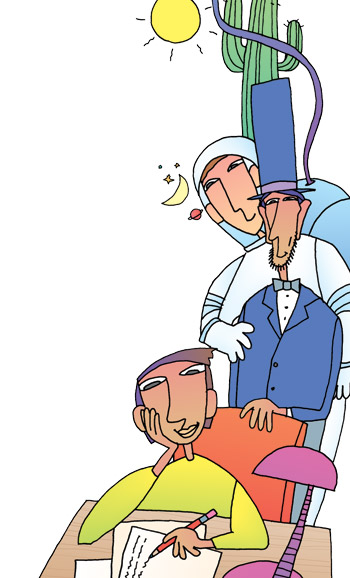Warm-Up for Research Reports
In this unit, you will research a variety of sources to write a report about an important person.
What Is a Research Report?

A research report involves a deep exploration of a topic. Like an explorer, a researcher must seek out new things. But instead of searching new lands, researchers search books, articles, Web sites, and other sources to discover information about a topic. Then they share the most important parts of what they find in a written report.
When you write a research report, you must do two things: (1) learn as much as you can about a specific topic by reading, observing, reflecting, asking questions, and so on, and (2) share this information in a clear, organized paper.
Your mission in this unit is to develop a research report about an important person from history, science, or math. You'll want to make sure your topic is someone who truly interests you, because you will spend a lot of time learning about this person.
Thinking by Summarizing
A good researcher is able to pick out the most important things other people say about a topic. Often this information will appear in long texts, such as books or magazine articles. Rather than taking notes of the whole text, you can summarize the key information in your own words.
Sample Article
Breaking Barriers
by Janet Lee
When NASA launched its first space shuttles in the 1960s, only male fighter pilots were considered fit to be astronauts. Women, it was believed, didn’t have the flight experience to succeed in space. Male-only space crews continued until the 1980s. Two major changes helped make space travel a reality for women like Sally Ride.
The first major change was the Equal Employment Opportunity Act of 1972. This act required organizations like NASA to consider women for the same jobs as men. As a result, NASA began advertising to women on college campuses. Sally Ride spotted one of NASA’s ads while she was studying physics at Stanford University.
The second major change was the creation of a new category of astronaut. “Mission specialist” astronauts were experts on special areas of space life. This type of astronaut did not need piloting experience to join a crew.
In 1978, Sally Ride was among the first six female candidates to join NASA. On June 18, 1983, she became the first American woman to travel to space, and the barrier between American women and space was officially broken.
Sample Summary
Summary of “Breaking Barriers”
Topic Sentence: States the main idea According to “Breaking Barriers” by Janet Lee, two changes helped American women fly space missions. The first was the Equal Employment Opportunity Act of 1972. This made women and men equals for hiring. Body Sentences: Support the main idea The second change was NASA’s new type of astronaut called “mission specialists.” A mission specialist did not need to be a fighter pilot to go to space. Closing Sentence: Shows why the main idea matters Both changes helped Sally Ride become the first American women to travel to space in 1983.
Summarize an article.
Follow the tips for writing a summary. Then read the sample article and summarize it using your own words. Make a copy of this Google doc or download a Word template.
- Underline key ideas as you read.
- Write the title, author, and main idea in the topic sentence.
- Write key ideas from the reading in your own words.
Separate Doesn’t Mean Equal
by Carson Leonard
Thurgood Marshall was a civil rights lawyer who became the first ever African American to serve on the Supreme Court, though he is best known for his role in a legal case that changed America for the better.
Before 1954, some state laws required black and white students to attend separate public schools. The segregated schools were supposed to be “separate but equal,” but conditions in the schools were not equal, with black schools coming up on the short end of facilities, resources, and opportunities.
Marshall was a lawyer for a group of African American parents from Kansas who sued the state because they believed the law violated their rights. The case was called “Brown versus Board of Education.”
Marshall argued that segregated schools violated individual rights according to the 14th Amendment of the Constitution. In 1954, the Supreme Court ruled in his favor, and segregated public schools became unconstitutional, as they remain so today.
Teaching Tip
You can use alternative readings for this activity based on your students' research topics.